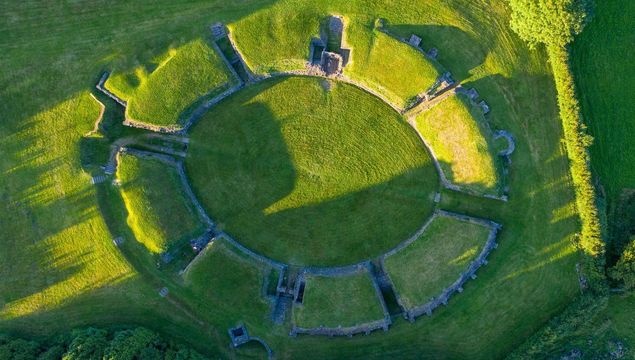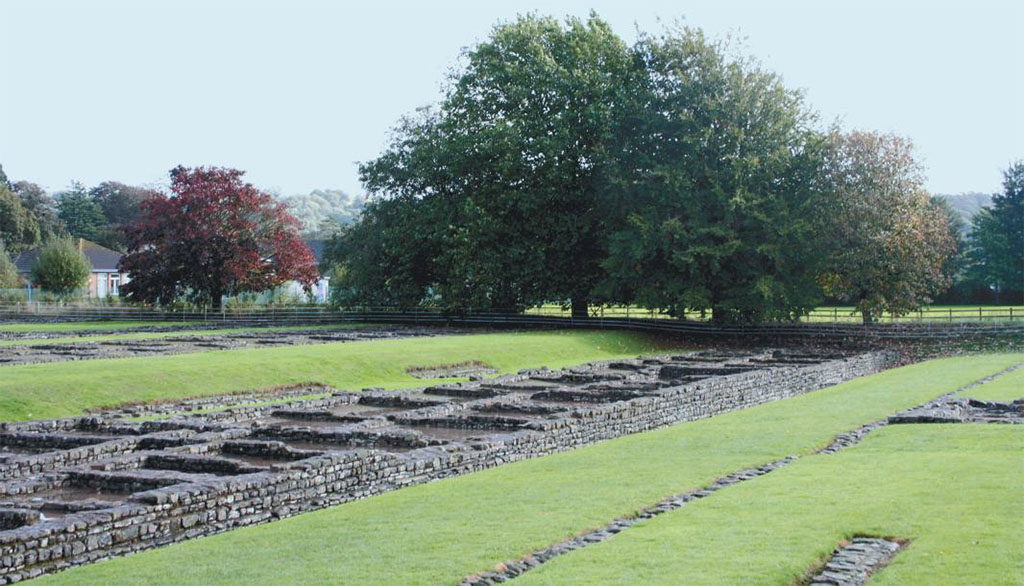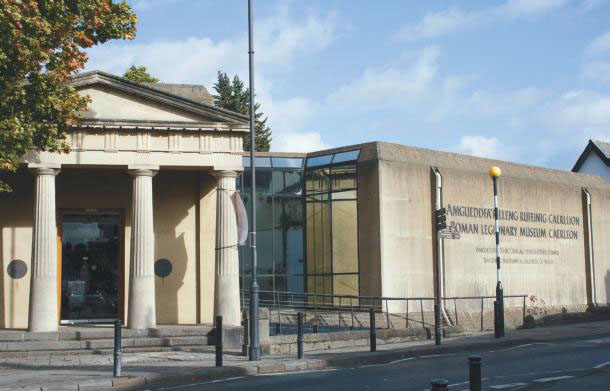
Some 6,000 Roman legionnaires gathered in Isca’s amphitheater for sport and ceremony.Getty
Where ancient Roman history and legend make romance in the small Welsh town of Caerleon.
Almost 2,000 years ago, the small Welsh town of Caerleon on the River Usk was an all-mighty, bustling metropolis, its cobbled streets wore smooth by the foot traffic of Roman soldiers. Today the sleepy village provides perhaps the best evocation in the country of Rome’s three-century military occupation of Britain.
Welcome to Isca, major Roman port on the Severn Estuary and home of the Second Augustan Legion. Its location at the northern headwater of the Bristol Channel proved an ideal base for one of three standing legions of the Roman Army stationed in the Roman-occupied province of Britain. From that strategic spot, the legion could be dispatched across South Wales, into the Midlands or anywhere in southwestern England for any contingency.
Some 6,000 professional soldiers made their home in Isca, recruited into the legion from across the Roman Empire. Recent discoveries on the Usk riverbanks have provided dramatic evidence of the large and busy harbor that existed there in the 200 years of Roman occupation from AD 75. Via the harbor, traces of which had long disappeared, the army was supplied with goods from Rome and across its provinces, reinforced with new postings and communicated with the broader Empire. A constant stream of olive oil and wine, ceramics and tools, dignitaries and dispatch riders arrived in shallow-draft ships on well-known routes that hugged the Atlantic coastline down to the Mediterranean.
If much was expected of the Roman army, much was provided for them as well. A huge complex of heated baths facilitated a recreational regimen and social life as well as hygiene. An amphitheater large enough to accommodate the legion of 6,000 soldiers provided entertainment, spectacle and military competition.
Over the centuries after Rome withdrew its army from Britain, Isca faded into insignificance. The structures and infrastructure of a once vital and affluent military city decayed into nothingness. The valley of the Usk and the neighboring hills became sparsely populated with farms. As happened in many places, the stonework of disused Roman buildings was carted off in bits and pieces to be built into village houses and walls and farm buildings surrounding Caerleon. The silt and soil of the centuries covered much of the evidence of Roman occupation. What remained, however, were the foundations of the only Roman legionary barracks left anywhere in Europe and Britain’s most complete Roman amphitheater.
The army barracks are a parade of housing rows, each row housed a unit of 80 soldiers and their commanding centurion. Eight soldiers shared a two-room apartment. The rear room was the sleeping area, and the front a communal space for equipment and personal belongings. At the head of the block were the larger rooms of the centurion.
Along the embankment beside the barracks rows, the foundations of the kitchen ranges are still intact. In the corner of the block, the elaborate plumbing and foundations of the latrine block are complete enough to identify their functions.
TIPS AND TIDBITS
Caerleon is easily accessible. From the M4, Junction 25, just follow the B4596 along the River Usk a mile or so into town. In Caerleon, stay at the Priory Inn, or nearby at the 5-star Celtic Manor resort. There are many other options just a few miles on in Newport.
That courtyard garden called The Ffwrrwm? Sited on the old Roman market, they simply transliterated into Welsh: the Forum.
The four files of barracks left visible today could have housed only 320 men. In its heyday, Isca would have required 75 such blocks to accommodate the 2nd Augustan Legion.
It is not that difficult to imagine a legion of 6,000 in place around Caerleon’s amphitheater. The circle is virtually complete, with the entrances for performers, combatants and officials, a shrine to the gods and even what would have been a “green room.”
While most of Isca’s archaeological remains lie underneath the contemporary town of Caerleon, a wealth of finds over the years is gathered in the National Roman Legion Museum on High Street. www.cadw.wales.gov.uk
Through its exhibitions and artifacts the museum does a superb job of explicating life at this furthest outpost of Rome. Just down the street, the Roman Fortress Baths have enclosed an entire recreational complex of heated baths, exercise rooms and an open-air swimming pool. All under cover today, the entire complex closely resembles a modern leisure center. Both offer free admission to visitors. www.museumwales.ac.uk/en/roman

The footprint of the Roman barracks block remains after almost 2,000 years. DANA HUNTLEY
As centuries pass in such historic venues, history often melds into romance, and so it was with the lost city of the legion. Though much had disappeared, what remained was dramatic. Legend says that King Arthur himself made Caerleon his headquarters and that the amphitheater was indeed his famous Round Table. As tales of Arthur, his knights and valiant deeds became all the rage in the Middle Ages, Caerleon emerged as a favorite site with storytellers. In Wales they were gathered as the Mabinogion. Geoffrey of Monmouth (just up the road) linked Caerleon with Arthur in his History of the Kings of Britain, and Thomas Malory often placed King Arthur in the ancient fortress community. Even Alfred, Lord Tennyson came to town for inspiration when working on his own Arthurian masterpiece, The Idylls of the King.
There may well be fire in the smoke of the Arthurian romances. In actuality, the historic Arthur was more likely a Celtic warlord and king of Powys, who made his capital at the long abandoned Roman city of Viroconium—now Wroxeter Roman City near Shrewsbury. He would, however, have been very familiar with Caerleon, and may well have employed its location and amphitheater as a meeting place and encampment during his southern campaigns against the encroachment of the Anglo-Saxons.

Thousands of artifacts recovered over the years from the Roman city have been gathered for interpretation at the Roman Legion Museum. DANA HUNTLEY
Today, Caerleon is a pretty, quiet small town. St. Cadoc’s Church, begun in the 12th century, stands over the site of the old Roman principia in the heart of 2nd-century Isca. Caerleon’s Arthurian connections show up in a few place names and souvenir shops, and some fine wooden sculpture in a courtyard garden called The Ffwrrwm. Sculptures on show also include “the World’s Biggest Lovespoon.” With a dozen charming pubs and restaurants within the old fortress walls, there is not a chain store or eaterie in sight. The Bell Inn, though, has been pulling pints since 1602, when it began life as a coaching house.
Across the hills into the Cotswolds, with the Corinium Museum and nearby Chedworth Roman Villa, Cirencester provides an unparalleled perspective on domestic life in Romano-Britain. The Roman fort of Housesteads on Hadrian’s Wall evokes what the soldier’s life was on the frontier of the furthest outpost of the Roman Empire. Perhaps none of the many impressive remnants of Britain’s centuries as a Roman province, however, provides quite such a complete picture of the organization and life of the Roman army as the lost city of Isca. That modern Caerleon is a warm, friendly and rewarding place to visit is the proverbial icing on the cake.
* Originally published in 2014, updated in Aug 2023.





Comments